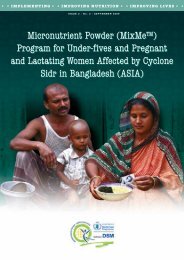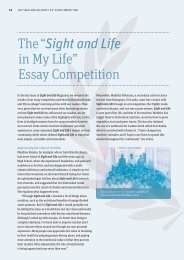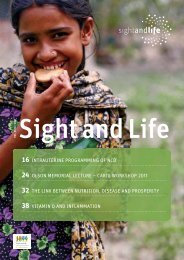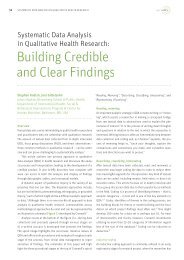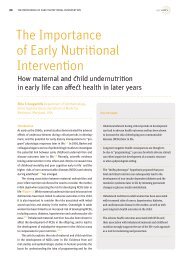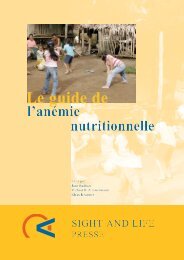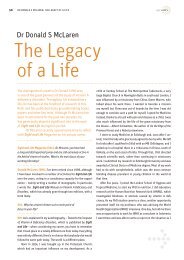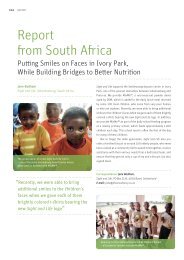Sight and Life Magazine 1/2011
Sight and Life Magazine 1/2011
Sight and Life Magazine 1/2011
Create successful ePaper yourself
Turn your PDF publications into a flip-book with our unique Google optimized e-Paper software.
SIGHT AND LIFE | VOL. 25 (1) | <strong>2011</strong> THE FIRST GLOBAL CONFERENCE ON BIOFORTIFICATION 6565remarks on the need to build momentum around linking agriculture<strong>and</strong> nutrition to address food insecurity. While fundingfor agricultural interventions has been on the decline in recentdecades, Ambassador Garvelink reiterated the US Government’srecent commitment to increasing funding for agricultural <strong>and</strong>nutrition interventions, <strong>and</strong> to continuing the advancement ofbiofortified crops.Dr Howarth Bouis, Director of HarvestPlus, presented anoverview of biofortification progress. He identified fivemajor challenges:1. Identifying optimal delivery strategies for gettingbiofortified foods to people;2. Ensuring <strong>and</strong> measuring the public health impactof biofortification;3. Developing a better underst<strong>and</strong>ing of how foodsimpact human nutrition;4. Getting the agricultural sector to prioritize improvingnutrition; <strong>and</strong>5. Getting the nutrition community to prioritize agriculturein order to improve nutrition.Figure 1 shows a proposed framework for establishing biofortificationas a sustainable solution for micronutrient malnutrition.Conference participants were encouraged to provide their feedbackon the framework through an online forum:http://biofortconf.ifpri.info/figure 1: Broad categories for investments to establishbiofortification as a sustainable strategy$ MidstreamBreeding& NutritionResearch (2)$IncreaseBreedingEffectiveness<strong>and</strong> Capacity(5a)Ownershipby AGDecisionMakers (5b)UpstreamResearch (1)Downstream”Pilot“Delivery (3)MeasureImpact (4)Internat.& RegionalAdvocacy (7)$Increase Bioavailability<strong>and</strong> EfficacyEvidence(6a)Ownershipby Nutrition/Public HealthDecisionMakers (6b)Nicholas Kristof, Pulitzer Prize-winning columnist for the NewYork Times, delivered day two’s keynote address. He encouragedparticipants to think about ways to raise the visibility ofmicronutrient malnutrition in the media, by doing a better jobof “selling their story” <strong>and</strong> building emotional connections tothe issues.Navyn Salem from Edesia Global Nutrition Solutions deliveredthe keynote address on day three. She focused on the linkbetween the private <strong>and</strong> public sectors, given Edesia’s work ondelivering ready-to-use therapeutic foods for the treatment ofacute malnutrition. Her comments provided potential strategies“Biofortification must use multipledisciplines <strong>and</strong> channels to promote<strong>and</strong> disseminate crops”on how biofortification must use multiple disciplines <strong>and</strong> channelsto promote <strong>and</strong> disseminate crops.Commissioned papers <strong>and</strong> moderated panel discussionsTwo papers had been commissioned for the conference. The first,From HarvestPlus to harvest driven: How to realize the elusive potentialof agriculture for nutrition? by Lawrence Haddad of theUK’s Institute of Development Studies, focused on how agriculturecan be used, more effectively, to improve nutrition.He answered three questions: 1) What are the pathwaysbetween agriculture <strong>and</strong> nutrition? 2) Is the potential being realized?<strong>and</strong> 3) What can be done to increase the realization ofthis potential? After presenting his paper, Roger Beachy of theUSDA, Shenggen Fan of the International Food Policy Research⇢



